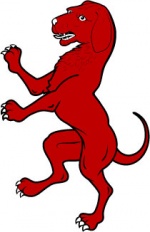Dog: Difference between revisions
(add image) |
No edit summary |
||
| Line 11: | Line 11: | ||
* [[greyhound]]s, [[saluki]], [[Afghan hound]]s, talbots and [[borzoi]] |
* [[greyhound]]s, [[saluki]], [[Afghan hound]]s, talbots and [[borzoi]] |
||
* other [[hound]]s, particularly [[bloodhound]]s [[deerhound]]s and an earlier form of [[wolfhound]]s |
* other [[hound]]s, particularly [[bloodhound]]s [[deerhound]]s and an earlier form of [[wolfhound]]s |
||
* [[terrier]]s -- given that the West Highland (white) terrier was bred for James VI/I, they were clearly popular at the end of [[period]] even if not, at that time a distinct breed |
|||
* [[terrier]]s |
|||
* [[husky]]s |
* [[husky]]s |
||
* [[poodle]]s, both standard and toy (the toy poodle was used to keep fleas off of nobility) |
* [[poodle]]s, both standard and toy (the toy poodle was used to keep fleas off of nobility) |
||
Revision as of 00:59, 21 April 2006
The dog is a quadruped mammal, almost certainly descended from the same root-stock as the visually-similar wolf. Together with the cat, it became, during pre-history, the main domesticated species in Europe. It hunted and herded for man, guarded his homes, was used as a pack animal, put in wheels to turn meat in the kitchen, pulled carts and used as sport in bear and bull baiting and (on occasions) was trained to fight in his wars. In Japan they were also used as archery targets. The cat, on the other hand, killed mice, drank milk, and looked elegant.
Spiritually the dog was seen as unfailingly faithful (hence the adjective dogged) and hard-working. For this reason, when its loyalty failed, it was noted and "dog" became a term of abuse in some circles.
King Arthur had a famous hunting dog, Cabal, who is supposedly buried on a Welsh mountain.
Prince Llewelyn had a wolf dogge called Gelert to whom he erected a monument in the 13th Century.
Types of period dogs
- greyhounds, saluki, Afghan hounds, talbots and borzoi
- other hounds, particularly bloodhounds deerhounds and an earlier form of wolfhounds
- terriers -- given that the West Highland (white) terrier was bred for James VI/I, they were clearly popular at the end of period even if not, at that time a distinct breed
- huskys
- poodles, both standard and toy (the toy poodle was used to keep fleas off of nobility)
- some spaniels
